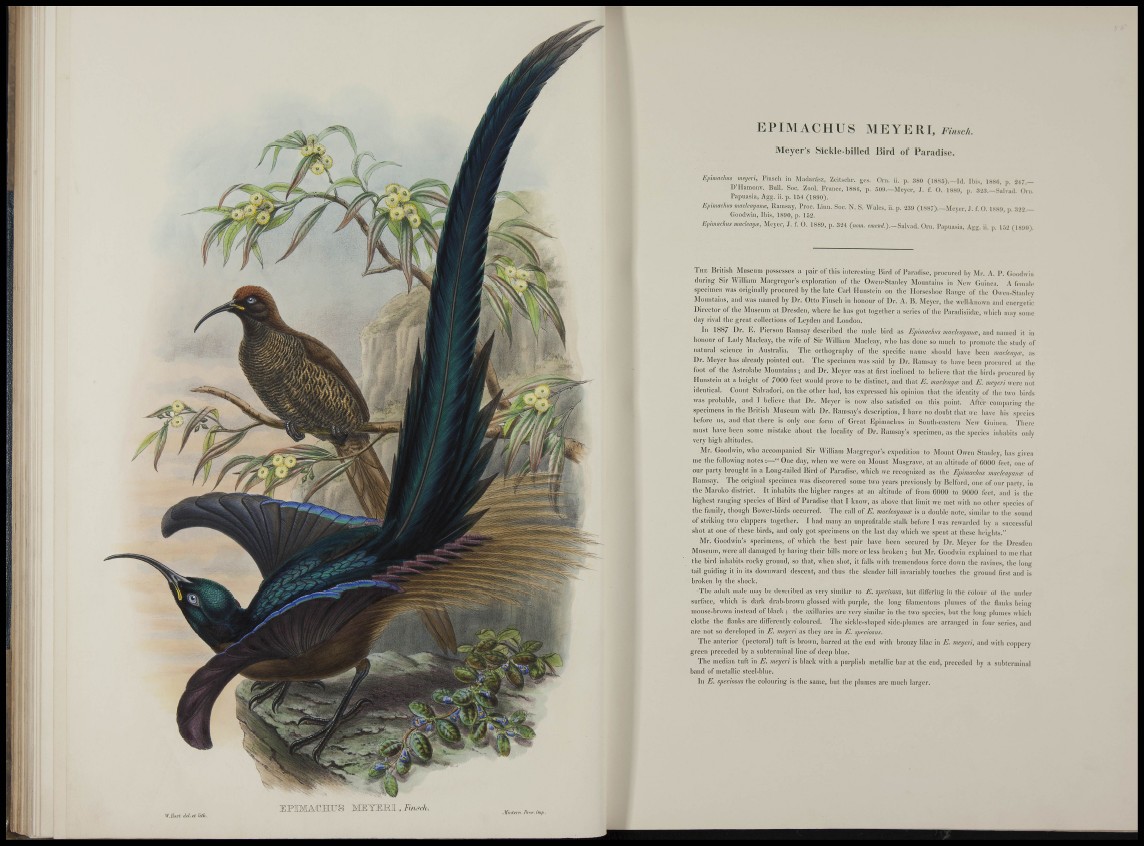
pr
ì .
I l '
li
E P I M A C H U S M E Y E II I , fìusc/,.
Meyer's Sickle-billed Bird of Paradise.
Epimachns meyeri, Finsch in Madaifcz, Zeitschr. gcs. Oni. ii. p. :)80 (1885).-J>1. Ibis, lH8li, p. 217.—
D'Hamoiw. Bull. Soc. Zool, France, 188(1, p. no!).—Meyer, J. f. O. 1S8!), p. :ii-).-yalvad. Orii.
Papunsia, Agg. ii. p. 154 (18«0).
Eiihnachm madcaymia:, Ramsay, Proc. Linn. Soc. N. S. Wales, ii. p. 23!) (1887).—Meyer, J. f. O. 188!), i>. :i22.—
Goodwill, Ibis, 18!)0, p. 1S2.
E,n,iwclms maclemj^e, Meyer, ,1. f. 0 . 188!), p. 324 (nom. «H™rf.).-Salvad. Orii. Papiiasia, Agg. ii. p. IM (18!)(1).
THE Brilish Museum possesses ii pair of this iiitereslinj.- liird ol'I'aradise, procured liy Mr. A. 1". (iouilivin
during Sir William Miiegregor's e.vploralion of llie Owcii-Staiiley Mountains in New Guinea. A female
S|ieciineii was originally procured liy (he late Carl Hmistein on the Horseshoe Hauge of the Oweri-Htiinlcy
IMountains, and was named by Dr . Otto Finseh in honour of Dr. A. li. Meyer, the well-known and encrgcti'c
Director of the Mnsenm at Dresden, wliere he has got together a series of the I'aradisiidic, which may some
day rival the great collections of Leyden and Loiidou.
In 1887 Dr. E. I'icrson liamsay described the male bird as Jipimtic/m mr/ckni/aucc, ;uh] niwii:i\ it in
honour of Lady Macleay, tlie wife of Sir William Macleay, who has done so much to promote ibe study of
natural science in Australia. The orthography of the specific name should have hcen mmlmym, as
Dr. Meyer has already pointed out. The specimen was sai<l by Dr. Ramsay to have been procured at tlie
foot of the Astrolabe Mountains ; and Dr. Meyer was at first inclined to believe that the birds |irocured by
Hunsteiii at a height of 7000 feet would prove to be distinct, and that E. macleaijm and E. meyeri were not
identical. Count Salvador!, on the other had, has e.xpressed his opinion that the identity of the two birds
was ]irobabIe, and I believe that Dr. Meyer is now also satisfied on (his point. After comparing the
spccimcus in the British Museum with Dr. liamsay's description, I have no doubt that we have his species
before us, mid that there is only one form of Great E|)imachus in Soutb-easterii New Guinea. There
must have been some mistake about the locality of Dr. Ramsay's siiccimen, as the spceie.s inhabits only
very high altitudes.
Mr. Goodiviu, who accompanied Sir William Macgrcgor's e.vpeilition to Mount Owen Stanley, has given
me the following n o t e s O n e day, when we were on Mount Musgrave, at an altitude of COOO feet, one of
our party brought in a Long-tailed Bird of Paradise, which we recognized as (he Ephmdms mackaijanai of
Ramsay. The origiiud specimen was discovered some two years previously by lielford, one of our party, in
the Maroko district. It inhabits the higher ranges at an altitude of from GOOO to 9000 feet, and is the
highest ranging species of Bird of Paradise that I know, as above that limit we met with no other s])ecies of
tlie family, though Bowcr-hirds occurred. The call of E. macleoymre is a double note, similar to the sound
of striking two clappers together. I had many an unprofitable stalk before I was rewarded by a successful
shot at one of these birds, and only got specimens on the last day which we s|)cut at these heights."
Mr. Goodwin's specimens, of which the best pair have heeu secured by Dr. Meyer for the Dresden
Museum, were all damaged by having their bills more or less broken ; but Mr. Goodwiu e.xjiluiued to me that
the bird inhabits rocky ground, so that, when shot, it falls with tremendous force down (he ravines, the long
tail guiding it iu its downward descent, and thus the slender hill invariably touches the ground first and is
broken by the shock.
The adult male may be described as very similar to E. spedosus, but diHering iu the colour of the under
surface, which is dark drab-browu glossed with purjile, the long filameiitons plumes of the flanks being
mouse-brown instead of black ; the axillaries are very similar in the two species, but the long plumes which
clothe the flanks are dilferently coloured. The sickle-sliapcd side-phiines are arranged in four series, and
are not so developed iu E. meyeri as they are in E. sprciostis.
The anterior (pectoral) tuft is brown, barred at the end with bronzy lilac iu E. meyeri, and with cojijiery
green preceded by a snbtermiual line of deep blue.
The median tuft iu E. meyeri is black with a purjilish metallic bar at the eud, preceded by a snbtermiual
band of metallic steel-blue.
In E. spedosus the colouring is the same, but the plumes are much larger.
iv.//.<i-/ M.fi lit/,.
E P n i A C H U B IIE^YEMI. Fiiu-ch. . Viiitfrn /hv.'.im/i.